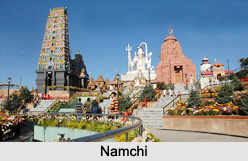 South Sikkim District has Namchi as the district capital. From Namchi, the administration is regulated. Here the tourist flow is inadequate and it is the hotspot for the trekkers for the long routes and the passes.
South Sikkim District has Namchi as the district capital. From Namchi, the administration is regulated. Here the tourist flow is inadequate and it is the hotspot for the trekkers for the long routes and the passes.
Geography of South Sikkim District
South Sikkim District lies at an altitude of 400 to 2000 meters and has a temperate climate for most of the year. Major urban centers include Ravangla, Jorethang and Melli.
Economy of South Sikkim District
South Sikkim District is the most industrialized district in the state, owing to the availability of flat land. Since the geology is stable, the roads are in good condition as compared to other parts of the state, which suffer from landslides. The district is also known for Sikkim tea, which is grown near Namchi.
Demography of South Sikkim District
According to the Population Census in the year 2011, South Sikkim district has a population of 146,742. The district has a population density of 196 inhabitants per square kilometers. South Sikkim District is one of the least populated regions of the state.
Administration of South Sikkim District
Namchi or Namtse is the headquarter of South Sikkim District which is nestled among the hills having elevation of 5500 feets. It has the panoramic view of snowcapped mountain of Mt. Kanchenjunga and vast stretches of valley full of snow.
Culture of South Sikkim District
The people of South Sikkim District are mainly of Nepali descent. Other ethnic groups include the Lepcha and Bhutia communities. Nepali is the most widely spoken language in the district. South Sikkim District was under the occupation of the Nepalese for 30 years in the eighteenth and nineteenth centuries.
Tourism in South Sikkim District
South Sikkim District has many tourist destinations. Summer is the peak time for the tourism approach here. Maenam Wildlife Sanctuary was established in 1987, with an area of 35 sq. kilometers to protect the wildlife and promote tourism in South Sikkim District. Namchi, Ravangla, Sikip, Jorethang, Rabong, Chozo Lake, Ralong Monastery, Manilakhang, Sakyamuni Cultural and Pilgrimage Centre, Borong, Sinolchu, Narsingh and Pandim, Tendong Hill, Maenam Hill, Solophok and Maenam Wildlife Sanctuary are the popular tourist destinations.






